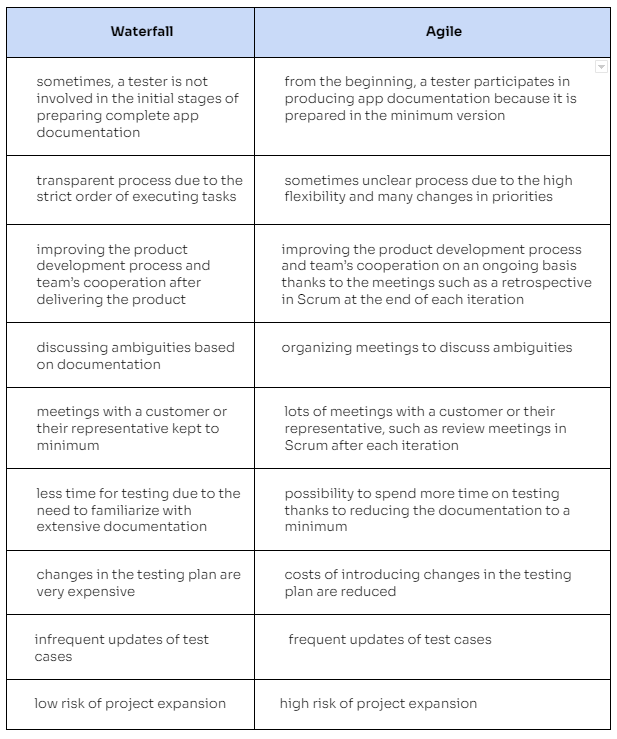Over time and with our growing experience, we work out methods to facilitate project work and enable us to be more efficient specialists. It all happens with trial and error in the background, with hours of testing and verification in a real work environment. We want to ensure that these methods are really effective and bring the desired outcome. Below, you can find my techniques, which I regularly use while working on Agile projects.
- The use of knowledge – without knowledge, it’s challenging to navigate; knowledge is like the foundation of the building, and none would exist without the foundation. Knowing how the Agile methodologies operate, what are their key assumptions and roles along the process, artifacts, and meetings in different methodologies, I can efficiently find myself in the team. The process of the framework allows us to carry out our daily tasks and, as a consequence – deliver the end product. I know who is responsible for what and to whom I should refer specific issues; I can properly prepare for meetings knowing what their goal is.

- Keywords – frequently, before an important meeting such as a demo (demonstration), where we introduce a customer to new functionalities delivered within a sprint, I write out the keywords. It enables me to conduct my presentation as planned; the keywords are a buffer in case I forget something. One of the examples is the presentation of quite an essential app’s functionality: it consists of sending a link/SMS via the web app’s console to a user who uses a mobile app version (either Android or iOS), and this allows them to share the view of mobile’s camera so that the service engineer could help the user remotely. I was really stressed out as this meeting included many business representatives from different parts of the world, and I wanted everything to turn out the best. Luckily, this method helped me to conduct the meeting according to my plan ? Here’s an example of putting this method into practice:
Functionality: sharing mobile’s camera view with a servicing engineer
1) Switch the plugin on
2) Send the link to the Android mobile
3) Share the Android mobile’s screen
4) Open the link
5) Take the screenshot via the web console
6) Send the SMS to the iOS mobile
7) Share the iOS mobile’s screen
8) Open the SMS
9) Take the screenshot via the web console
10) Questions
11) Thanks for participating
- Project notes – as we already know, only the essential documentation is conducted in Agile projects. Sometimes, there is no documentation because a customer wants to get the product with limited functionality (a Minimum Viable Product) as soon as possible, only to be able to start using it. Documentation is prepared at the end of the project when the major development work is completed. Thanks to that, documentation does not require as many updates as in the case of an ongoing project. In such situations, the notes turn out to be a blessing. They help me to refresh my memory of the findings made in the given project, especially when I work in two different teams simultaneously.
A template to prepare notes (I recommend using the Notepad++ tool):
Project: the test project
1) Name [first name_last name (project role, company)]:
Tomek (frontend, Craftware)
Robert (backend, Craftware)
Iza (manual tester, Craftware)
Bartek (automation tester, customer)
Natalia (product owner, customer)
Piotr (scrum master, Craftware)
2) Tests:
a) Testing environments:
Einstein (dev environment)
QA (test environment)
BI (test environment for business)
Master (prod environment)
b) Tasks statuses flow [flow of the testing process based on label in the tool for the test management, for example, JIRA]:
IN QA ? Test review ? Ready for DEMO ? Accepted by Business ? Delivered
Label naming may vary in individual projects!
3) Main application functionalities:
a) Adding a new customer
Main page ? Address book ? the ‘New customer’ button – The first name, last name, and address of a customer must be filled out in the form
*double-click on the Customer label opens the form with data
b) Removing customer
4) Keywords [here I put terms used within the project]:
Vibe – pop-up to customer service
FE – service engineer
- The art of compromise – as in life as in the professional sphere, working out a compromise is a useful ability. In Agile projects, due to the lack of complete product documentation expected by a customer, there can be many issues and ambiguities that should be cleared out on a regular basis. From the testing perspective, I must get more information on functionality when I find it not intuitive enough. This can cause risk, for example, when buttons for creating and deleting data are poorly arranged, a customer will not see them. In such a situation, I schedule a meeting with the team that is made up of different people and everyone has their own point of view. As a result, it is difficult to avoid disputes. A developer does not want to do the additional job, and I (software tester) wish to avoid the later risk because a customer will come to the same conclusion as me eventually, they will want to change the solution, leading to me updating already written test cases, and making the developer go back to the already completed task. When things like that happen, I use app screenshots (you may as well share the screen and show where the problem is) and arguments; both prepared in advance. Thanks to these, it will be easier to convince the developer and product owner of my idea or think of some other solution convenient for all interested parties.
Photo 1 – Waterfall vs. Agile – tester’s perspective
Conclusion
Each project, regardless of whether it is carried out in Agile or Waterfall, has its own work nature worth knowing. Each methodology has apparent advantages and disadvantages from the tester’s perspective or any other role in the project team. I think it’s good to have experience in both methodologies to find out which one suits your role best.
I hope my articles from the “Who is an Agile tester” series introduced you to this term even more and explained what it means to be an Agile tester. Maybe, they encouraged you to start working in such a project role?
- Senior Software Tester
-
A tester who has been associated with the Quality Assurance (QA) industry for 7 years; has worked for small companies and big corporations in such sectors as healthcare, pharma, telecom, and logistics. At work, he is opened to new challenges that he undertakes with full commitment to achieve the best results, as well as to improve processes. Privately, he likes to work out at the gym and take walks in the open air.


